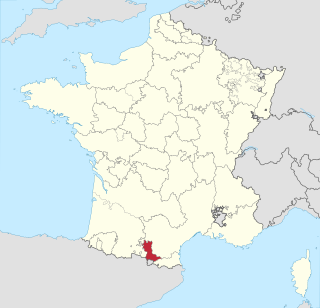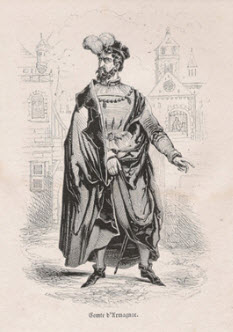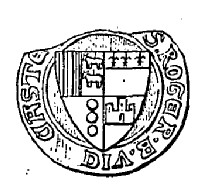
Mathieu de Grailly or Mathieu de Foix (died 1453) was Count of Comminges between 1419 and 1443.
Contents
He was the fourth son of Archambaud de Grailly, captal de Buch and Isabella, Countess of Foix.

Mathieu de Grailly or Mathieu de Foix (died 1453) was Count of Comminges between 1419 and 1443.
He was the fourth son of Archambaud de Grailly, captal de Buch and Isabella, Countess of Foix.
He was knighted in 1413 and became a member of the entourage of John the Fearless, Duke of Burgundy. For his loyalty, King Charles VI of France, allied with Philip the Good Duke of Burgundy, gave him Narbonne, of which he couldn't take possession, because it was under control of Dauphin Charles, then at war with his father and Burgundy.
At that time, he married Marguerite de Comminges, twenty years older than him, an authoritarian woman who allegedly had her second husband killed in prison. Fearing a similar fate, Mathieu had his wife locked up a few months later in the castle of Bramevaque and governed Comminges alone. Following his brother, he defected from the Burgundian camp to King Charles VII of France, who rewarded him by making him governor of the Dauphiné between 1426 and 1428.
After the death of his brother John I, Count of Foix, Matthieu became regent of his nephew Gaston IV and in 1439 he bought off Rodrigo de Villandrando and his raiders to leave the County of Foix.
Meanwhile, the unsatisfied people of Comminges petitioned the return of their Countess Marguerite from King Charles VII, who ordered her release. Mathieu refused and transferred his wife to Foix. Again allied with Burgundy, he became a Knight in the Order of the Golden Fleece in 1440. Charles VII put the County of Comminges under guardianship of John IV, Count of Armagnac and in 1441 war broke out between Foix and Armagnac, only interrupted in 1442 by a campaign against the English. After this campaign, Charles VII again ordered the liberation of Marguerite on 17 January 1443 and now, Mathieu was forced to obey. Marguerite was released on 9 March but died shortly after, leaving Comminges to the Crown.
In 1449 Mathieu accompanied Gaston IV to besiege Mauléon. He died 4 years later.
On 16 July 1419 he married Marguerite de Comminges (died 1443), no issue.
He remarried, in 1446, Catherine de Coarraze, and had two daughters Jeanne and Marguerite.
Mathieu had also two illegitimate children by unknown mistresses:

John I was a scion of the French royal family who ruled the Burgundian State from 1404 until his assassination in 1419. He played a key role in French national affairs during the early 15th century, particularly in his struggle to remove the mentally ill King Charles VI and during the Hundred Years' War against Kingdom of England. A rash, ruthless and unscrupulous politician, John murdered Charles's brother, the Duke of Orléans, in an attempt to gain control of the government, which led to the eruption of the Armagnac–Burgundian Civil War in France and in turn culminated in his own assassination in 1419.

The County of Foix was a medieval fief in southern France, and later a province of France, whose territory corresponded roughly the eastern part of the modern département of Ariège.

John V of Armagnac was the penultimate Count of Armagnac of the older branch. He was the son of John IV of Armagnac and Isabella of Navarre.

Eleanor of Navarre,, was a Navarrese princess and monarch. She served as the regent of Navarre from 1455 to 1479, during the absence of her father, and then briefly as the queen regnant of Navarre in 1479. She was crowned on 28 January 1479 in Tudela.

Gaston IV was the sovereign Viscount of Béarn and the Count of Foix and Bigorre in France from 1436 to 1472. He also held the viscounties of Marsan, Castelbon, Nébouzan, Villemeur and Lautrec and was, by virtue of the county of Foix, co-prince of Andorra. From 1447 he was also Viscount of Narbonne. Through his marriage to Eleanor, heiress of the Kingdom of Navarre, he also held the title of Prince of Navarre.

The viscounts of Béarn were the rulers of the viscounty of Béarn, located in the Pyrenees mountains and in the plain at their feet, in southwest France. Along with the three Basque provinces of Soule, Lower Navarre, and Labourd, as well as small parts of Gascony, it forms the current département of Pyrénées-Atlantiques (64).
The County of Fézensac was an 8th-century creation on the north-eastern fringes of the Duchy of Gascony following Charlemagne's policy of feudalisation and Frankish colonisation. The move was aimed at offsetting and undermining the authority of the duke of Gascony Lupo II after the setback suffered by the Franks at the Battle of Roncevaux in 778 and failure to restrain the Basques. That advance clearly displeased the Basques, with these policies sparking a stir on the banks of the Garonne.
John IV was a Count of Armagnac, Fézensac, and Rodez from 1418 to 1450. He was involved in the intrigues related to the Hundred Years' War and in conflicts against the King of France.

Alain I of Albret (1440–1522), called "The Great", was a powerful French aristocrat. He was 16th Lord of Albret, Viscount of Tartas, the 2nd Count of Graves and the Count of Castres. He was the son of Catherine de Rohan and Jean I of Albret. He was the grandson and heir of Charles II of Albret and became head of the House of Albret in 1471.
Joan of Artois, Countess of Foix, Viscountess of Béarn, was a French noblewoman, and the wife of Gaston I de Foix, Count of Foix, Viscount of Béarn. From 1331 to 1347 she was imprisoned by her eldest son on charges of scandalous conduct, dissolution, and profligacy.
John II, the Hunchback,, Count of Armagnac, of Fézensac, Rodez (1371–1384) and Count of Charolais (1364–1384), Viscount Lomagne and Auvillars, he was the son of John I, Count of Armagnac, of Fezensac and Rodez, Viscount Lomagne and Auvillars and Beatrix de Clermont, great-granddaughter of Louis IX of France.
The House of Armagnac is a French noble house established in 961 by Bernard I, Count of Armagnac. It achieved its greatest importance in the fourteenth and fifteenth centuries.
Eschivat IV Chabanais was Count of Bigorre from 1255 to 1283 and Count of Armagnac and de Fézensac of 1255 in 1256. He was the son of Jordan, Lord of Chabanais, and Alix de Montfort, Countess of Bigorre.

Isabella of Foix also known as Isabella of Foix-Castelbon was sovereign Countess of Foix and Viscountess of Béarn from 1399 until 1428. She was Countess of Foix in her own right, but shared power with her husband and later with her son. She succeeded as countess along with her husband upon the death of her childless brother Matthew.
John I, Count of Foix also known as Jean de Foix-Grailly was Count of Foix from 1428 until his death in 1436. He succeeded his mother Isabella, Countess of Foix. His father was Archambaud de Grailly.
Petronilla of Bigorre or Petronilla of Comminges was ruling Countess of Bigorre between 1194 and 1251. She was the only child of Bernard IV, Count of Comminges, and his wife Stephanie-Beatrice IV, Countess of Bigorre. Petronilla succeeded her mother in 1194 as Countess of Bigorre; she was also Viscountess of Marsan and Nébouzan through further successions. She reigned as countess for fifty-seven years, in which time she was married five times.

Archambaud de Grailly was Viscount of Castillon and Gruson from 1356 until his death, and from 1369 Count of Bénauges and Captal de Buch. He was the younger son of Peter II of Grailly and his wife, Rosamburge of Périgord and was Count of Foix by his marriage to Isabella, Countess of Foix.

Gaston I de Foix-Grailly was from 1412 to 1451 Captal de Buch, Count of Bénauges, and Viscount Castillon. He was a Knight of the Order of the Garter from 1438. Gaston was the second son and heir of Archambaud de Grailly and his wife, Isabella, Countess of Foix.
Margaret, Countess of Comminges (1366-1443), was a Countess regnant suo jure of Comminges in 1375–1443.

Roger Bernard IV of Foix was viscount of Castelbon and other Catalan lands bequeathed by his parents Gaston I of Foix viscount of Foix and Bearn and Jeanne of Artois.